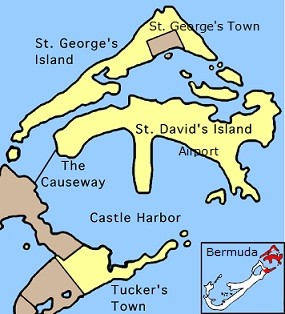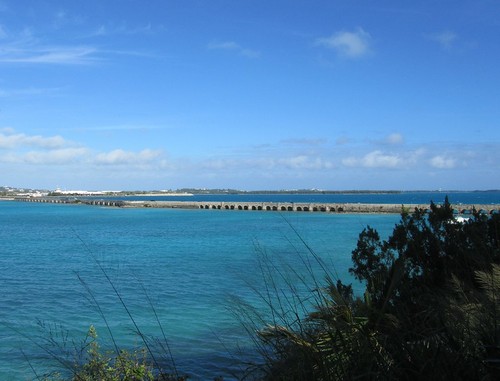Bermuda Causeway
The causeway is located at the north-eastern end of Bermuda and connects the mainland (starting from
Baileys Bay in Hamilton Parish) to the once isolated St. David's Island of St. George's Parish.
Today it is the only road connection for going across to St. George's from rest of Bermuda and serves as the only route to the airport which is located on Kindley Field road at St. David's Island.
Location of Causeway
Although the causeway is often confused as a bridge, it is not. It is actually a raised road.
The causeway was originally opened in 1871 after 4 years of construction work by the Royal Engineers. It's a narrow strip of reclaimed land at a short height made of stone blocks. There is a swing bridge at the eastern end of the causeway for ships to pass. Starting from 1612 when the first official settlement took place in Bermuda until the causeway was built across the
Castle Harbor, ferry was the only transport for crossing over the water area from one side to the other.
The ferry used to operate between the narrow strip of water between
Coney Island that was connected with the mainland of Bermuda and the
Ferry Island on the other side located in St. George's parish. Once the causeway was constructed in 1871, it eliminated the need for the ferry altogether.
The Causeway, Bermuda
In 1867, Lieutenant Albert Hime, a Royal Engineer was given the job to lead a team to construct this causeway. Hime was only 24 years old and never handled a project of such magnitude and complexity. However in four years time with the help of fellow workers, he built the causeway that started from
Blue Hole Hill at Bailey's Bay, went eastward up to Long Bird Island.
He also had to build a Swing Bridge at the far end that connected the Long Bird Island with St. Davids. It thus provided a continuous roadway and connection between Bermuda's mainland and St. George's Parish for the first time.
The causeway passes over four tiny islets in Castle Harbor on its way to the Long Bird Island. These islets that are now submerged under water and no longer visible, are called Cartwheel Islands since they are round in shape and looked like the wheels of a cart.
The original causeway was built on soft limestone structures. The iron casting work was done in England. The 1.8-mile road was about 22.5-foot wide and narrowed down to about 12-foot at the swing Bridge.
On September 19, 1871, Governor John Henry Lefroy opened it to the traffic. A grand opening ceremony was held that was attended by some 6,000 islanders, about half the total population of Bermuda of that time. It was by far one of the biggest events in the island. The Governor who was on the western side of the causeway, received a 17-gun salute before he declared it open.
The original causeway was not built for heavy traffic. Civilian motor vehicles were not allowed in Bermuda those days. General people only used horse carriages and bicycles on road. Later in 1930s with introduction of
Bermuda Railways that carried people and cargo across the island from east to west, the use of the Causeway became even lighter.
During World War-II, with U.S Air Force setting up the airbase at the Kindley Field where the present airport is located, military vehicles were allowed to move on the road. As a result, motor traffic on the causeway started to increase. In late 1940s when civilian motor vehicles in Bermuda were also permitted, traffic on the causeway increased dramatically.
However the causeway has been a repeated victim of lashing hurricanes over the years. In 1899 and after 28 years from its opening, the causeway was almost completely damaged by a severe hurricane and had to be rebuilt. In recent times, hurricane Fabian inflicted a heavy damage to the causeway in September 2003.
Currently the Government of Bermuda has appointed a group of international engineering consultants to study and recommend any alternative solution for crossing the Castle Harbor.
Reaching the Causeway
On bus routes #1, 3, 10 and 11. While coming from Hamilton City, the causeway starts after the Grotto Bay Beach Resort / Blue Hole Hill Park.
|
 By Raj Bhattacharya By Raj Bhattacharya
Raj, a seasoned travel writer and Bermuda destination expert, has extensive global travel experience. This website reflects his profound insights, garnered over nearly two decades of dedicated findings and research on the island. Raj has assisted countless Bermuda-bound visitors by providing direct, personalized responses to their queries and imparting his wealth of knowledge through this platform. This site serves as an indispensable guide for those seeking informed and reliable insights into Bermuda's treasures.
|
Related Articles
1) Check out
St George's Town to know about the historical Town of St. George, its attractions, activities, restaurants, hotels and more.
2) Check out
St. George's Parish to know about the parish where the town of St. George is located and all its attractions and activities.
|
Visitors' Reviews and Comments
Share your experience.
|


 By Raj Bhattacharya
By Raj Bhattacharya